Exercise1: Smallest to largest reach
While working on this project, I first became acquainted with the creative output of artists such as Tony Orrico, Sehen Wei, Jackson Pollock. I admit that his work has made a huge impression on me. But I decided that I would give in to some kind of experiment and start working according to the methods described in the exercise. So, I started to work using oil pastels on paper, using only the pressure of the finger then going to the wrist and then expressing my injections with an increasingly dynamic form moving from the shoulder, etc,. I admit that I performed with discipline. I was unconvinced about creating some forms, that I did not scratch any particular elements, but I gave in a very relaxed form to some kind of experiment, namely, I allowed my hands to move in an uncontrolled way after contact with paper. I controlled only the strength of my hands. Of course, dynamism and line strength can vary, it depends on the mood of the force with which we express our emotions or the external conditions of the music we listen to. All this has a great outcome on the effect that I made during the exercise. I was relaxed and expressed myself in a delicate way. I am not sure if I completed this task, or if I should show something more, like giving into the emotion according to the recommendations and the method of work that determined this exercise. But I certainly believe that I allowed my hand to leave marks only in the way described in the exercise.
PROJECT 2 ALTERNATIVE PAINTING TOOLS- GESTURE -THROW,DRIP,SPLASH,SCATER,GRAVITY
While working on this exercise I made a number of experiments – I spilled the spilled paint on the paper, I spread the excess paint using a palette knife, scraped off the amount of paint, leaving different marks. I added inpasto gel to the paint, for example, in order to thicken layer that work and then scratch the part. After some experiments I concluded that I had to plan what I wanted to present in my final job. This kind of work is very experimental and requires a specific place for the work of a real studio. Unfortunately, I have to think how all these tasks adapt to home conditions and it’s very difficult; I need to specify what material I will work on, what kind of paint to use, etc. When working on paper using acrylic paints, the effect of my work will be different than if I used more lacquering paints on a smoother slippery surface.
So I came to the conclusion that I need to adjust my terms about working on this project. I need to compromise on the canvas and allow accidental events to be part of my work, instead of trying to make it perfect. I noticed that in all these random events I created, one can imagine a kind of landscape or object that all depend on the imagination. I started to steer in direction and try create something like trees or branches in a less controlled way. I started by accidentally forming a layer of paint which I rubbed off using a variety of tools, leaving an unintentional, accidental part of control so that the image presented my intention.

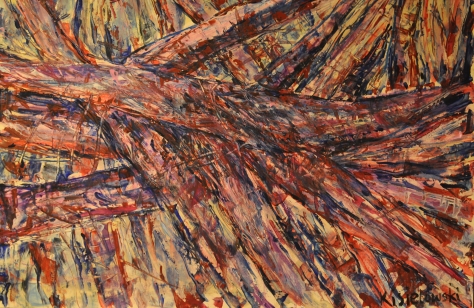
This form of creation is completely new to me, creating something from the case of clinging to me. Of course, I’m familiar with the art that Jackson Pollok creates, but is this form of creation in me or I can do something like this?
This is a very difficult task. I think that to add more rhythm and diversify this project, I will use dry pastels as a medium. I could add experience to these experiments, which is why I started drawing on a painted surface, and sometimes brushing pastels with clean water, or correcting lines with a paint-soaked brush. I always try to remain very indigenous meaning I will leave a part of the creation to a coincidental accident. As we know, in a certain moment of creation, we are not free, we only concentrate more on the size of the brush, adding small elements that mark our work with the effect what we want to get.
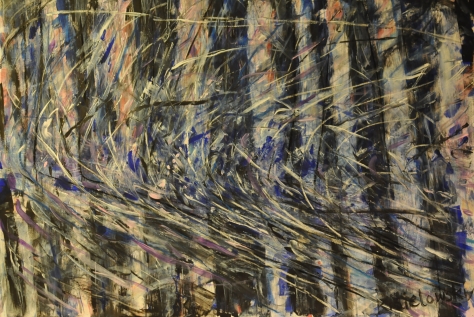
I am convinced that even Pollock had to plan his artistic creations in a very disciplined manner, and his genius does not result from accidental splashing of paint, but from a very successful selection of the types of things he left on canvas. I have come to the conclusion that this whole experimental process of creation is aimed at freeing our imagination and letting us create something more free or less controlled. It is necessary to divide our imagination by letting ourselves be accidented and at the same time express ourselves in a more expressive manner. I managed to get some work that I would never be able to do in this way, so I started to go in the freer direction and see how it would result.
I’ve created the forms that I’ve just begun to recall have imaginative landscapes, so I thought it was a good direction and I should make it.
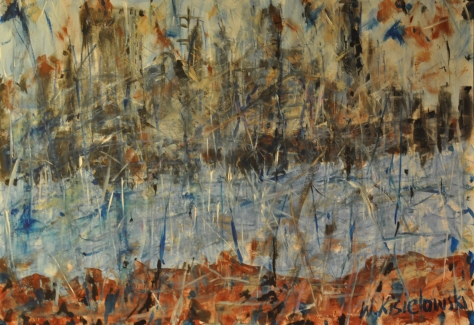
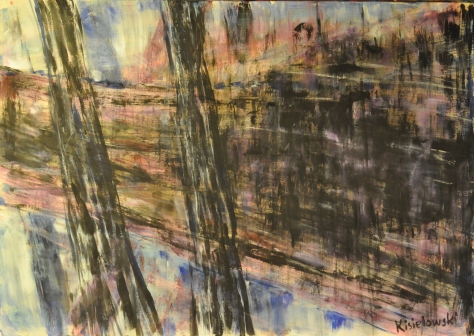
PROJECT 3 VISUAL REFLECTION
I painted what reminded me of rookie old buildings, castles and ruins of a building. The intention was quite casual but I interpreted it in a way that when thinking about creating a diagram to connect it in some way; I started to line up lines, using crayon and consequently create some post-industrial landscape. I made a brush and bent it dry when trying to draw lines to draw sort posts, lanterns and pipes, but in such a way as to be unmistakable for us to guess what. I wanted to create something like a diagram which will force us to read this image as a kind-of post-nuclear landscape.
So it will force us to read it in one direction only.
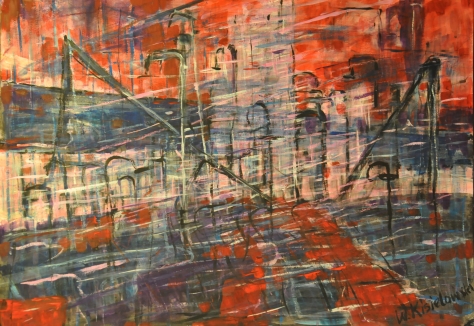
I then painted the image on the canvas trying to get a thick effect using impasto gel. I used the paint knife to start painting, then went onto paintbrush. I noticed a lot of white structures which reminded me of trees and branches, so I decided to create something on the tree pattern. It was a completely unintended process of creating this kind of landscape which resulted in a completely different case. I showed it to my family and we decided it resembles a dreamlike landscape, so I tried to finish it, maybe too carefully to create such an impression; the white trees were originally part of a kind of map or diagram, but it came out completely. I returned to this exercise working on the main project.

I wondered what the purpose of creating the diagram is, and how to use it later. I came to the realisation that any kind of map forces the recipient to read our message in the right direction, and you can suggest something to the recipient, and emphasize the nature of our work. You can force someone to think one-way but can also ask the guesswork to disperse his attention in a different direction and make us look in a way that makes no sense whatsoever. You can play a certain game with the recipient.
Cecily Brown (born 1969) is a British painter
Cecyli fascinated me with the light that affects the plane of the picture. At first glance, her paintings seem to be created accidentally, colors, structure intertwine with each other, then comes to give a specific character, a more eloquent content that regulates the seemingly chaotic space in the image. Such a process of creation is very interesting, free motions of the brush and other tools, the paint that spills over the image’s frown only to get a more rhythmic effect. The colors are very vivid, and it is difficult to resist the impression of watching the work, we do not analyze them in terms of the compositions that are very refined. we simply view the image from a distance as a vivid colorful abstract object and then we read it in a more sophisticated way.
Rainy Day Women, 2007; oil on linen, 12.5 x 17 in.
http://altoonsultan.blogspot.com/2015/06/cecily-brown-painterly-thickets.html

Skulldiver IV, oil on linen, 2006-07
Carnival and Lent, oil on linen, 2006-08
http://www.lacan.com/grancover32.html
Maria Moser
1948 Frankenberg am Hausruck (Austria)
Contemporary painter and wood engraver
Maria Moser won numerous advancement awards and distinctions in her Austrian homeland. I interested her creativity because of the technique she uses. The artist creates using a variety of paints mixes techniques, working both on paper and canvas. The technique which she uses is very experimental, often paint is spreading over the surface, very important is what she paints, are very simple like unconnected geometry or some imaginary objects that co-exist with the background of the image or vice versa. This is an example of a very complex process where the artist borrows some elements recognizable by nature and transform them into very stable abstract compositions. I recognized her as an artist who is particularly interested in experimental work on paper.

Lauernder Kern | Moser, Maria

Glühend | Moser, Maria
https://www.galerie-maringer.at/artist-gallery/moser-maria/
During this project, I was thinking a lot about the idea of performing art and in the analysis I was helped by the articles on the pages of the Tate publishing house.
https://www.tate.org.uk/art/art-terms/c/conceptual-art
Conceptual art
Conceptual art is art for which the idea (or concept) behind the work is more important than the finished art object. It emerged as an art movement in the 1960s and the term usually refers to art made from the mid-1960s to the mid-1970s.
https://www.tate.org.uk/art/art-terms/p/performance-art
Performance art
Artworks that are created through actions performed by the artist or other participants, which may be live or recorded, spontaneous or scripted














